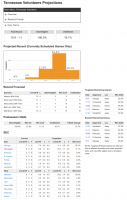But the odds of UT doing what you describe are lower than Clemson winning out and making the playoffs. That's why their odds are better than UTs.
It’s a challenge for sure. At this point it’s mostly getting the win against Georgia but Kentucky and South Carolina have chances to beat us too. Not great ones, but if they aren’t taken seriously or we have a really bad day for some other reason they could beat us. Vanderbilt and Missouri shouldn’t be too problematic but remember Georgia nearly lost to Missouri, so there chances are low but non-zero against us.
I’m still trying to understand the Georgia matchup but if you look at the various models most of them give us like 20% plus or minus a few points to win. Kentucky and South Carolina have similar chances to beat us as we do Georgia per said models.
Anyway, basically our percentages of going undefeated are so low because of Georgia especially but really the whole field when taken together probably deals us a loss in most projections. Could even deal us two, and of course we could also go undefeated.
I think in like 80% of scenarios we are 11-1 or 12-0. Next most likely is 10-2 which covers a big chunk of the remaining 20%. 9-3 and under barely being a blip. Disclaimer though: these are just guesses having casually looked at some popular model predictions. Haven’t done my own serious analysis so we could totally have better chances for 12-0 than might first appear.
Georgia has one of the weakest schedules out there when you don’t include us (actually even with us it’s something ridiculous like 70th+ or something). That maybe means it could be skewing some projections and our chances are actually better.
I’m sure they do account for strength of record and such to some extent but they also rely on a number of offensive and defensive variables. The weight that they give various things could be wrong in some cases when certain stat differences are between two teams are large.
Which is to say, I’m not willing to concede that a 20% projected chance for us to beat Georgia is actually the same as a 20% projected chance for Kentucky or South Carolina to beat us. At least not until I understand their processes better.
One possibility is Georgia’s chances are skewed. Another possibility is that Georgia is actually very good but we are their only serious opponent except maybe Oregon, and if they do beat us they have an easy path to the SECCG.
If we do lose to Georgia.. Since a loss to Georgia means they are probably winning the east, this keeps us out of the SECCG in most ways the rest of the season plays out. At least in theory. Georgia is either really good like most believe and will get a chance to prove it when they play us, or they are talented but maybe not as good as advertised.
Important to remember that predictive tools are cool but imperfect, and even when they are accurate we still have non-zero chances to upset. They had Alabama looking a lot like Georgia in terms of our chance to win. Even if the models are right we still get to the SECCG and even go as far as the NC championship game at percentages that can happen.
Such tools are helpful but can and often are wrong. Pre-season sp+ iirc had us at most like 8-4 or 7-5. We have already beaten I think 3-4 teams they had us losing depending on what Florida was predicted as. Obviously it didn’t play out that way, but the tools were probably weakest pre-season and have more data to work with now.
A lot of football has been played since then which should make the tools better now, but especially when I look at a team like Georgia who has played almost noone and struggled at times I wonder if there isn’t a higher than normal probability that they are being given too much credit for many of the variables that look good on paper.
Similarly I wonder if our own chances could be underrated because some statistics that might look pedestrian compared to Georgia and other top teams (think: most of the defensive stats) have been skewed by us usually playing stronger opponents.
All of this is just conjecture of course. So.. I guess we will see.




